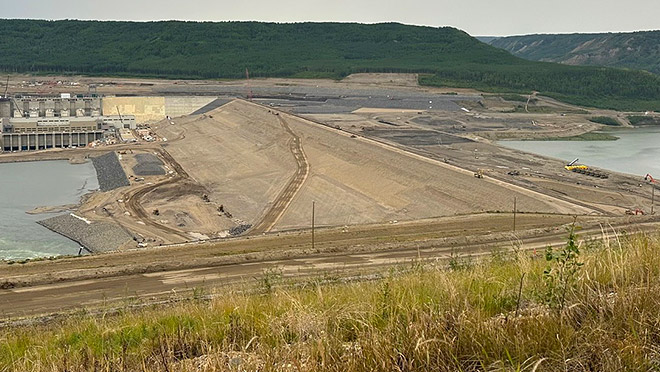Site C earthfill dam is complete: bring on the water

Site C hydroelectric project in northern B.C. passes major milestone
What's it like to stand at the base of an earthfill dam more than a kilometre long, half a kilometre wide at the base, 20 storeys high, and made of some sixteen million cubic metres of sand, clay, and rock?
"Just a year ago, it was only half the height, and you could still see the river valley on the other side," says Matt Drown, BC Hydro's project director responsible for the main civil works on the Site C Clean Energy Project. "Now it's like a mountain – all you see is sky."
We've reached a major milestone with the completion of Site C's earthfill dam, the third hydroelectric dam on the Peace River. Located just southwest of Fort St. John, construction of the dam began in 2021 and was designed to withstand a major (one in 10,000 year) earthquake.
Completion of the earthfill dam is one of the essential milestones required before filling the Site C reservoir. As there are still a number of key project areas to be done – including the approach channel, spillway gates and powerhouse intake gates – filling of the reservoir will only begin once all that work is complete.
Filling the reservoir is expected to take about two to four months.
Construction on the Site C project began in July 2015 and remains on track to have all six generating units in service by 2025. Once complete, Site C will provide the equivalent amount of energy needed to reliably power about 450,000 homes, or 1.7 million electric vehicles per year. It will serve as a vital cog in our electrification plan, which will help B.C. homes and businesses switch from fossil fuel to clean electricity to reduce greenhouse gas emissions in the province by 900,000 tonnes by April 2026.
Site C will generate about 35% of the energy produced at the W.A.C. Bennett Dam, with just 5% of the reservoir area. It will use water already stored in and released from the Williston Reservoir above the Bennett Dam, water that also flows through the second dam and power station on the Peace River, at Peace Canyon.
A lot of dump trucks, plus a 5-km-long conveyor belt
Most of the material for the earthfill dam was taken directly from the dam site, while other material was sourced locally offsite and transported to the dam site on a five-kilometre-long conveyor belt.
"We put almost 16 million cubic metres of dirt and rock in this thing," marvels Drown. "One big dump truck carries about 10 cubic metres. Do the math and you get about 1.6 million dump truck loads of dirt. That's such a huge scale."
Site C's reservoir will be three times wider than the Peace River, will stretch 83 kilometres, and will be at its deepest (52 metres) close to the dam. To handle the weight of all that water, and to withstand a one-in-10,000-year earthquake, the earthfill dam was built with a mix of materials. Glacial till with clay impervious to water forms the core, a mix of sand, gravel and larger rocks forms the shell that protects to core, and a surface layer of large rocks – many weighing 250 kilograms or more – forms a layer of armour known as rip rap.
"Imagine your garden," says Drown, in explaining the role of rip rap. "If you spray the top soil in your garden with a hose, it will just wash away. But if you put rock over it, it won't wash away anymore. So at Site C, when it's raining or there are waves on the reservoir splashing against it, it's protected. It's basically erosion protection."
Filling the reservoir: a diversion tunnel's role
Since 2020, two diversion tunnels have been directing water around Site C to allow for construction at the site. But they'll soon play different roles in the filling of the reservoir.
Over the summer, crews closed one of the tunnels and installed four rings inside to shrink the tunnel's diameter at certain points so that the flow of water during reservoir filling can be restricted.
"We'll open that tunnel again, and close the other tunnel," says Drown. "So we'll have a restricted-flow tunnel that will force the water to start backing up into the reservoir. Basically the water will start ponding up behind the dam."
Up to 2,500 workers at a time have been on duty at Site C
By the time Site C is finished, the project will have created an estimated 13,000 person-years of direct employment. Most work 14 days on, seven days off, with the bulk staying at the 1,600-capacity worker lodge.
"The nice thing about the seven days off is that a lot of workers get to return home," says Drown. "At the airport, you look at where the flights are going – there's a flight to Calgary, Edmonton, Nanaimo, Kelowna, and other parts of the province and Alberta."
In the month of September, there were nearly 5,500 people working on Site C, with about 65 per cent from B.C. and more than 900 workers – about 20 per cent – from the Peace River Regional District. Additionally, nearly 500 workers are Indigenous, and more than 500 are women.
While working at Site C, workers at the lodge are housed in single-occupancy bedrooms with ensuite bathrooms, TV and wifi services. They have access to amenities such as a gym, convenience store, and coffee shop. The lodge also has its own health clinic which provides access to primary and preventative health care, along with work-related injury evaluation and treatment.
Related: